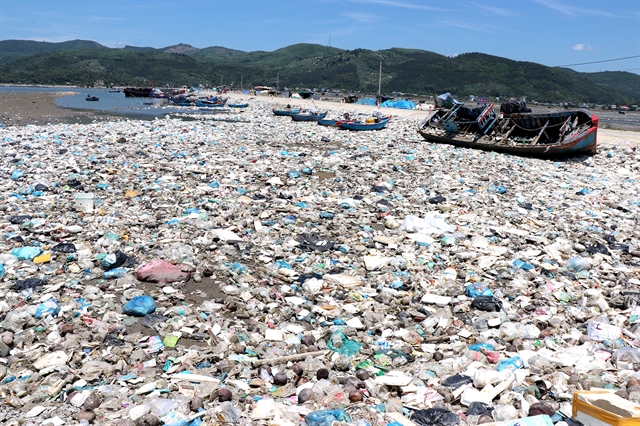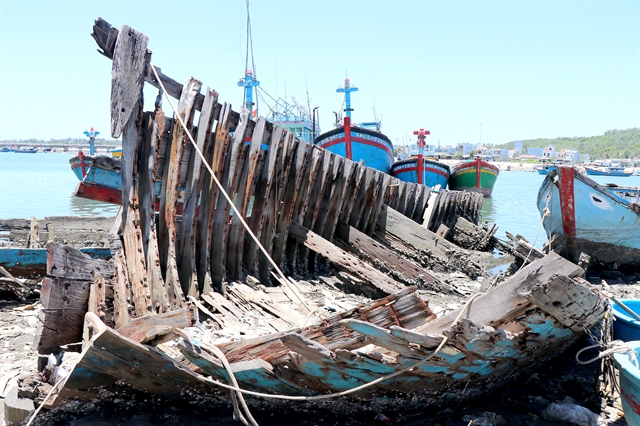 Society
Society

 |
| Tens of tonnes of waste covering the Sa Huỳnh saltwater lagoon. — VNA/VNS Photo Phạm Cường |
QUẢNG NGÃI — A waste treatment plant has been inactive for years due to local residents' protests, causing a build-up of waste that is decaying at the seaside, saltwater lagoons and residential areas in the Sa Huỳnh coastal region, Quảng Ngãi province.
Covering an area of 210 hectares, the Sa Huỳnh estuary in Phổ Thạnh Ward, Đức Phổ Town is an ecosystem where local residents raise various aquatic species and provide water for salt fields.
However, the accumulated waste in recent years is currently affecting the lives and health of the local people, Nhân Dân (People) newspaper reported.
With nearly 50 square metres in the large salt field, Nguyễn Thị Huyền, a local farmer in Thạnh Đức residential area, has divided it into four smaller parts for salt production.
In the last two years, she has only worked on three sections, while the remaining part has been abandoned due to the overflow of wastewater and decomposing waste.
Next to the salt fields are small piles of waste that have been burned, mixing with decomposing waste.
The water in the abandoned salt sections has changed colour, formed bubbles, and carries a foul stench that spreads across the entire salt field.
"The waste fills the entire lagoon area and is scattered everywhere. Every afternoon, we gather the waste and burn it," Huyền said.
On the main road of Thạnh Đức residential area, one side is the saltwater lagoon, while the other side is the salt field.
Waste floats all over the water surface of the lagoon. Domestic waste and debris from fishing boats are piled together over an area of thousands of square meters on the water surface. Decaying waste clings to the concrete banks of the road that stretches for over a kilometre.
During low tide, tires, metals, and construction materials at the bottom of the lagoon become visible.
Plastic bottles, food, and household items are carried by the tides, flooding the area around Thạnh Đức bridge and the aquaculture and seafood cultivation zones.
"When the tide is high, we don't see much waste in the aquaculture area, but during low tide, it becomes more apparent. In the past, this area used to support a lot of aquaculture. Now, due to excessive pollution, we are raising fewer fish," local resident Nguyễn Văn Thành said.
Phổ Thạnh Ward covers an area of nearly 30 square kilometres and is home to 26,000 residents, making it one of the most densely populated areas in Quảng Ngãi Province.
Sa Huỳnh coastal area witnesses the constant movement of fishing boats entering and leaving the port. As a result, there is a substantial amount of household waste and waste from boats and seafood processing operations.
Both new and old waste, as they decompose, emit strong foul odors, polluting the air in residential areas, neighbourhoods and groundwater sources, especially impacting the aquaculture and salt cultivation areas.
Residents collect rubbish to bury and burn it around their homes, empty plots within communities, port areas, and roads, posing risks for the development of diseases, the newspaper reported.
A waste treatment plant was constructed in Phổ Thạnh Ward in 2018 with an investment of VNĐ52 billion (US$2.17 million).
However, after operating for just three months, the plant had to close due to opposition from the local residents, who cited that it was too close to residential areas.
After inspections, it was found that there were some irregularities in terms of planning assessment, distance regulations, and environmental impact assessments.
The provincial authorities engaged in many dialogues with the locals, suggesting that the plant should continue operating to address the accumulation of waste.
But they did not have a common voice and the factory had to stop working and people live with pollution.
Abandoned fishing boats
 |
| Damaged boats are abandoned at Sa Huỳnh port, causing environmental pollution and hindering fishing vessels' access to the port. |
Moreover, abandoned fishing boats have remained at the Sa Huỳnh fishing port for many years, making the environment here become cluttered and affecting the operation of boats in the port, Vietnamplus.vn reported.
All the fishing equipment on the boats has been removed, leaving only the empty boats along the Sa Huỳnh coastline.
Hồ Hoàng, a local fisherman, said he bought a boat in 2014. After several years of operation at sea, the boat became old and deteriorated.
He planned to dismantle and bring the old boat remains home. However, due to financial difficulties, the process of dismantling the old boat cost VNĐ4-5 million, so he just left it at Sa Huỳnh lagoon.
According to statistics from the People's Committee of Phổ Thạnh Ward, there are currently 26 damaged boats left along the Sa Huỳnh fishing port, Thạnh Đức 2 bridge, and the Sa Huỳnh saltwater lagoon.
Among them, some boats were damaged at sea and towed back to the port, some were burnt, some had their owners missing at sea, and others shifted their operations due to losses in the fishing business.
During hot and sunny days, the boat remains are clearly visible for fishermen to avoid, while during rainy and stormy seasons, the boat remains are submerged, posing a danger to fishing boats entering and leaving the port.
To completely address the issue, the provincial People's Committee has requested that this situation be handled urgently in the area of Sa Huỳnh fishing port and some localities before October 15 to ensure environmental sanitation and operation of boats accessing the port as the stormy season is approaching. — VNS




